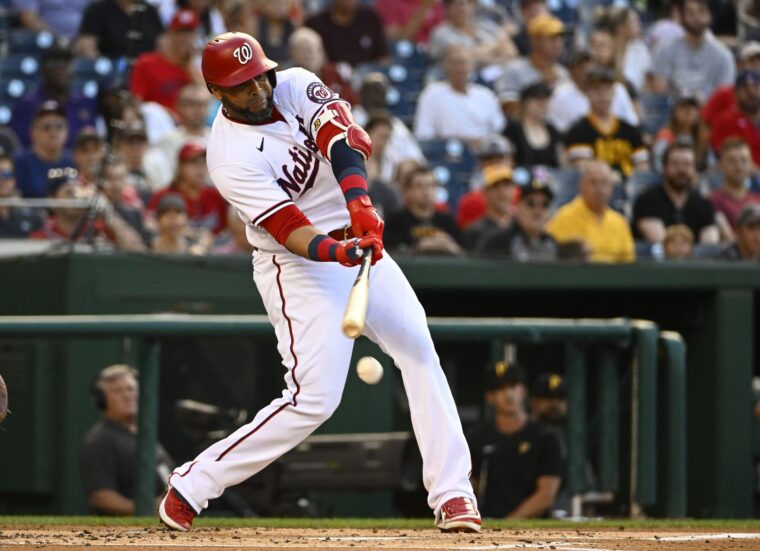
Brad Mills-USA TODAY Sports
Note, this is part one in a short two part series. Article two will be released later today.
The New York Mets have been incredibly active so far this off-season, but they still need to add some real power to the middle of their lineup.
There was no doubt that the Mets had a few big needs to address heading into this off-season, including pitching, and they made a good start by signing elite closer Edwin Díaz to a record five-year, $102 million deal. Then, after losing Jacob deGrom to the Texas Rangers, the front office moved quickly to replace him with another elite top of the rotation arm in Justin Verlander. The nine-time All-Star signed a two-year, $86-million contract. Veteran starter José Quintana also came on board after agreeing to a two-year, $26-million deal.
General manager Billy Eppler made it clear on Monday that the Mets are far from done, and this turned out to be very true as late Saturday night the Mets added Japanese star Kodai Senga to a five-year, $75-million deal. Among other moves this off-season, the front office also re-signed outfielder Brandon Nimmo to an eight-year, $162-million deal, as well as handed out a one-year, $10-million contract to veteran reliever David Robertson.
However, one other need that can’t be forgotten is addressing the lack of power that hurt this team both down the stretch and in the postseason last year. While the offense as a whole tied for fifth in the majors in runs scored, they tied for 15th in home runs with just 171. That lowly total also placed them with the fourth-least among teams who made the postseason. The Mets also ranked 16th in isolated power percentage, which measures raw power, with a mark of .153.
Furthermore, per Fangraphs, the lineup finished with the fifth-worst hard-hit rate in MLB at 28.6%. That further underlines the fact that you need a lineup at least partially built with power in mind in order to succeed in the postseason. If you take a closer look at the playoffs in 2022, the Guardians were just one example of a team that mashed their way to success in the Wild Card before forcing a Game 5 with the New York Yankees in the ALDS.
While the Mets did find some success with their contact-first approach and old school style of baseball under the vastly experienced Buck Showalter, today’s MLB is built on power and the longball. Adding further credence to their struggles due to a lack of power, New York ranked just outside of the bottom ten in average exit velocity and barrel percentage.
Furthermore, the team got little to no production from the designated-hitter (DH) spot, which didn’t help matters at all. The DH is meant to provide pop and a big bat from the middle of the lineup but, instead, the Mets saw their designated hitters combine for a total of 183 strikeouts. They also hit just 18 home runs and finished with 83 RBI. Collectively, the DH slashed .218/.314/.371 in 2022 which just isn’t going to get the job done.
Looking ahead to 2023, Pete Alonso will be relied upon to provide raw power once again while the hope will be that Daniel Vogelbach can hit more consistently as a DH. Darin Ruf, who was an unmitigated disaster after being acquired from the Giants at the trade deadline, could be traded and he surely will not be the answer to the Mets’ power struggles in any case. There is the possibility that highly-rated prospects Francisco Álvarez, Mark Vientos and Brett Baty could also provide some pop in full-time roles in 2023, but it would be unfair to rely just on their bats so early on in their major league careers.
Instead, there are plenty of options out there for the Mets when it comes to picking up a big bat. As we’ve explored here at MMO in depth, the free agent market is still awash with big-time mashers including the likes of J.D. Martinez, who would solve a lot of problems at the DH spot. Other cheaper alternatives include veteran slugger Nelson Cruz, as well as Matt Carpenter who enjoyed somewhat of a resurgence with the Yankees in 2022. Other names still available are Trey Mancini, Michael Brantley, and Adam Duvall.
Any of the aforementioned names wouldn’t cause the already bloated 2023 payroll to skyrocket too much. Even if it did, owner Steve Cohen would be willing to pay the price if it gave his team a better chance of winning next year. Note, specific options the Mets can potential target will be in a follow-up piece later today.
While the additions of Verlander and Senga has made the rotation better and the re-signings of Díaz and Nimmo helped keep this team intact, the Mets will likely live or die by their ability to hit for power in 2023. Therefore, the front office can’t afford to just roll last year’s team back out or rely on prospects who aren’t yet tested at the major-league level. It has been proven time and time again that power wins the day in modern-day baseball. As such, the New York Mets would be harming their chances of winning a World Series in 2023 if they don’t address their very real need for power in the coming weeks and months.
Part two of this short two article series will be dropped later today. It will specifically analyze certain power options the Mets should target.















